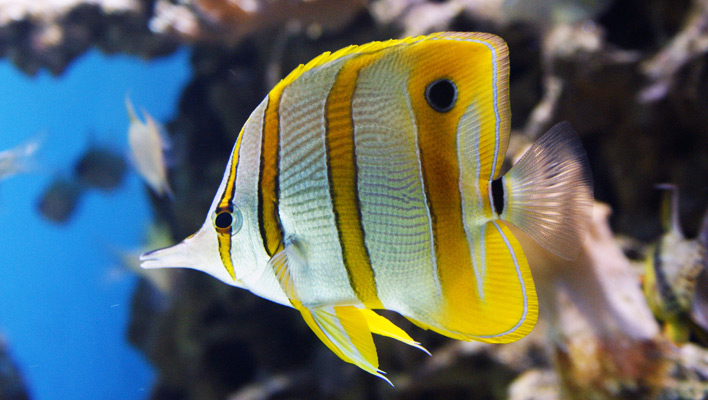Having a fish that refuses to eat anything offered—or having a specimen that had been eating suddenly lose all interest in food—is a problem virtually every marine aquarium hobbyist can expect to encounter at one time or another. While such “hunger strikes” can be extremely frustrating and disconcerting, they can usually be overcome with patience, persistence, and a little ingenuity. Here’s how:
First, an ounce of prevention
As regular salties know, I’ve emphasized the following point in many previous posts, but it bears repeating: It’s critical to make sure that any fish you’re planning to bring home is eating before you buy it. Ask the dealer to feed it right in front of you. This doesn’t guarantee the specimen won’t go off feed due to the stress of transfer, but at least you’ll know it had been eating (which means it will likely do so again) as well as what it was eating, which will give you a good starting point for reintroducing foods.
Check water quality and watch for health issues
A fish going off feed is often one of the first signs of a water-quality problem and should prompt one to test all parameters to ensure they’re in the appropriate ranges. Likewise, refusal to feed is a very common early symptom of disease, so it’s important to observe any hunger-striking specimen closely for other symptoms that might arise—and be prepared to treat as necessary.
Match the food to the fish
The more similar the food items being offered are to the fish’s natural diet, the more likely the specimen is to accept them. For example, you’ll have greater success tempting your average zooplanktivore with something like mysid shrimp than with pellet food.
Of course, the particle size of the food makes a difference too. A school of tiny chromis might ignore the aforementioned mysids simply because they’re too big to fit in their mouths, but then take to frozen cyclops without hesitation. On the other hand, a larger predatory species might show no interest in plankton-sized offerings but then greedily gobble up table shrimp.
Consider presentation
Sometimes how you present a food is just as important as the food item itself. For instance, species accustomed to nibbling and picking food items from the reef structure or substrate may not react to foods drifting in the water column, and vice versa.
Presenting foods in a manner that’s palatable to a hunger-striking fish often takes a little creativity. For example, one trick I’ve used successfully on several occasions to elicit a feeding response from picky butterflyfishes is to place small food items, such as mysids or finely chopped clams, in one half of a bivalve shell wrapped with bridal veil or a similar mesh material. This makeshift feeding station prevents the food from drifting away in the current so the fussy specimen can warily approach and pluck out the food at its leisure.
Go live
Many persnickety feeders can be enticed to break a hunger strike by introducing some live food items, such as blackworms, mysids, or grass shrimp. However, long-term feeding of live foods isn’t always practical (or even desirable in many cases), so once you’ve got the specimen eating, you’ll want to gradually wean it onto non-living items.
Try target feeding
Newly introduced specimens are sometimes so shy and nervous that they won’t emerge from hiding for any reason, even to feed. In this case, it may be necessary to try target feeding the specimen—e.g., presenting an appropriate food item directly to the fish on a feeding stick or gently squirting the food right toward its mouth with a turkey baster or pipette.
Don’t force the issue
When a fish is agonizingly reluctant to eat, the temptation to “flood the zone” by dropping different food items into the tank all day long can be powerful. Don’t give in to it! Overfeeding in this manner will take a serious toll on the aquarium’s water quality, which will only stress the fish further and compound your problems. If a feeding attempt fails, wait until later in the day—or even the following day—to try again.
Be patient
Keep in mind that it’s not uncommon for newly introduced marine fish to refuse food for several days to a few weeks before finally accepting something. For us warm-blooded bipedal mammals, who are accustomed to “fueling the furnace” at least three times a day (with a few snacks thrown in for good measure), it’s hard to imagine that fish can go such a seemingly long time without a meal and still survive. But they can and do. Keep trying to elicit a feeding response using the various techniques mentioned above, but don’t panic if it takes some time for the specimen to come around.




I always try to get fish on pellet food if possible to make my life a little easier. I have found putting the pellets where they are drawn into the stream of a power head helps to get a feeding response out of a specimen that has been taking live foods.
Ah, great suggestion, Matt! I can see how the powerhead effluent would give the pellets just enough motion to make them appear alive.